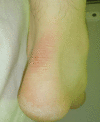Levofloxacin-induced Achilles tendinitis in a young adult in the absence of predisposing conditions
- PMID: 20376902
- PMCID: PMC2852805
- DOI: 10.3349/ymj.2010.51.3.454
Levofloxacin-induced Achilles tendinitis in a young adult in the absence of predisposing conditions
Abstract
Fluoroquinolones (FQs) represent a major class of antimicrobials that have a high potential as therapeutic agents. Although FQs are generally safe for the use as antimicrobials, they may induce tendinopathic complications such as tendinitis and tendon rupture. A number of factors have been suggested to further predispose a patient to such injuries. Hitherto, a few published cases on tendon disorders have implicated levofloxacin, a more recently introduced FQ. Here, we report a patient with levofloxacin-induced Achilles tendinitis, who exhibited no known predisposing factors. A 20-year-old man without any history of disease or medication presented with community-acquired pneumonia. Levofloxacin was administered and 3 days later, he complained of pain in the left Achilles tendon and revealed redness and swelling in the area. On suspecting Achilles tendinitis, levofloxacin treatment was discontinued, and the tendinitis subsequently improved. To our knowledge, this is the first case report on FQ-induced Achilles tendinitis in Korea.
Conflict of interest statement
The authors have no financial conflicts of interest.
Figures
References
-
- Takayama S, Hirohashi M, Kato M, Shimada H. Toxicity of quinolone antimicrobial agents. J Toxicol Environ Health. 1995;45:1–45. - PubMed
-
- O'Donnell JA, Gelone SP. The newer fluoroquinolones. Infect Dis Clin North Am. 2004;18:691–716. x. - PubMed
-
- Lipsky BA, Baker CA. Fluoroquinolone toxicity profiles: a review focusing on newer agents. Clin Infect Dis. 1999;28:352–364. - PubMed
-
- Kahn JB. Latest industry information on the safety profile of levofloxacin in the US. Chemotherapy. 2001;47(Suppl 3):32–37. - PubMed
Publication types
MeSH terms
Substances
LinkOut - more resources
Full Text Sources
Medical


